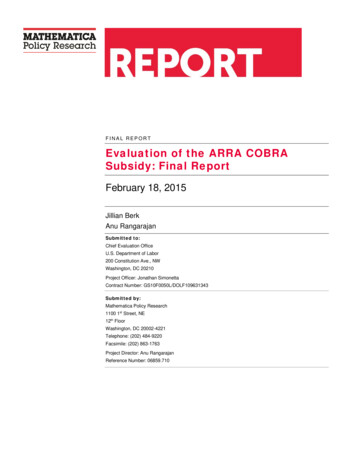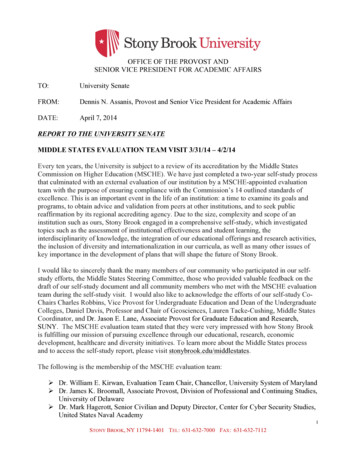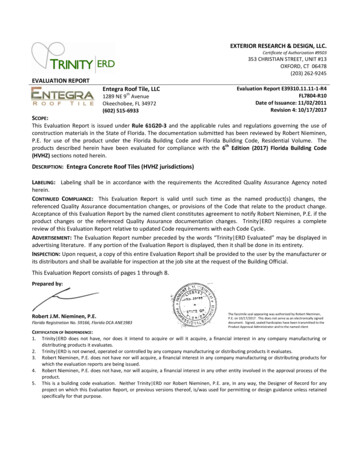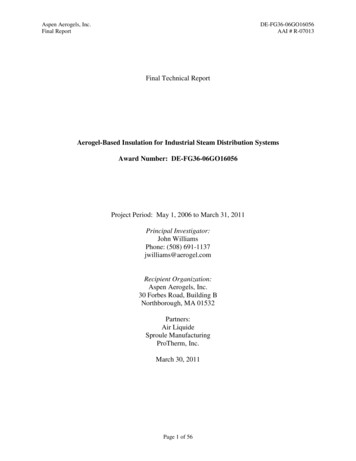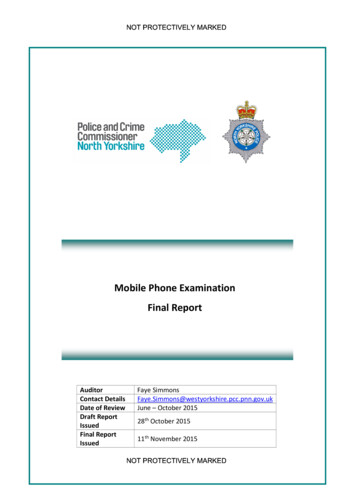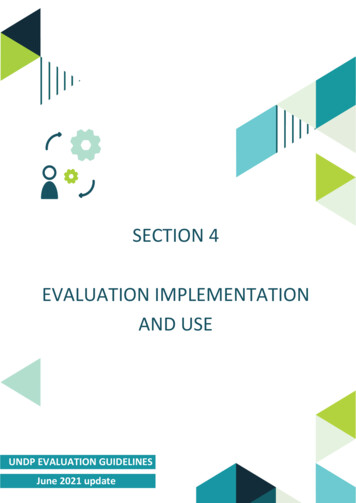
Transcription
Connecticut State Targeted Response to the Opioid Crisis TI 17-014Final Evaluation ReportAuthorsEleni Rodis, M.S., Principal Investigator & Kathryn E. Parr, Ph.D.,Co-Principal InvestigatorIlva Llakmani, M.S. – Evaluation CoordinatorDomenic DeLuca, M.S. – Research Assistant1
Table of ContentsAcknowledgements . .4Part I: Introduction and Program Overview . . .5A. Evaluation Team Description 5B: Project Aims . . . . .61. Treatment Initiatives . . . .92. Recovery Support Initiatives . .93. Prevention Initiatives . . . 104. Training and Workforce Development . . .10Part II: Overall Data Collection/Evaluation Components . .11Part III: Overall Evaluation Findings . 13A: Treatment and Recovery Supports . . . .141. Service Client Demographics . .142. Treatment and Recovery Support Findings . . . .18B: Prevention, Training and Workforce Development Services . . 191. Roles of Prevention and Training Participants . . . .202. NARCAN Reversals . . . . . .213. Prevention and Training Findings . . . . . .22C: Mapping Analysis – Overdose and Drug Arrest Data . .231. Methods . . . .232. Opioid Overdoses . . . .243. Drug Arrests . . . . . .264. Opioid Prescriptions . . . . . .285. Geospatial Findings Summary . . . . . . .29Part IV: GPRA Sub-Study . . .29A: Overview 291. GPRA Descriptions and Administration . . .292. Training . . .313. Challenges . . . . . .312
B: GPRA-Related Results.321. Recruitment and Follow Up . .322. Demographics and Background Data . .333. Substance Use Reporting at Baseline . 354. Family and Living Conditions . . 385. Employment . . .416. Health and Service Utilization . . .417. Social Connectedness . 458. Completion and Discharge Data . . .47Part V: Conclusions . . . .52Appendix A. BGAS Treatment Template 54Appendix B. BGAS Recovery Services Template . .54Appendix C. BGAS Prevention & Training Template.55Appendix D. Interview Training Presentation 563
AcknowledgementsThis work was supported by a grant from the Substance Abuse and Mental Health ServicesAdministration (SAMHSA) to the Connecticut Department of Mental Health and AddictionServices (DMHAS; TI17014). DMHAS subcontracted with the University of Connecticut,School of Social Work to conduct the project evaluation. We acknowledge the support of all thestaff at the DMHAS Research Division (RD), the management and staff at the service agenciesinvolved in this project, and especially DMHAS leadership. We particularly want to thank thethree enhanced MAT sites (The Village for Children and Families, Cornell Scott Hill HealthCenter, and CNV Help) for participating in the additional interviewing component of theevaluation. Special thanks are given to evaluation staff Martha Marin, Melissa Ives and DianneDesilets for assistance in project management and data analysis. In addition, great appreciationis expressed for the STR project director Lauren Siembab and her staff for their dedicated workto combat the opioid epidemic.The views, opinions, and content expressed in this presentation do not necessarily reflect theviews, opinions, or policies of the Substance Abuse and Mental Health Services Administration(SAMHSA), or the U.S. Department of Health and Human Services (HHS), or DMHAS.4
State Targeted Response (STR) Final ReportI. Introduction and Program OverviewThis study was an evaluation of the State Targeted Response (STR) project. STR was a two-year,federally-funded program through a grant from SAMHSA, the Substance Abuse and MentalHealth Services Administration, to the Connecticut Department of Mental Health and AddictionServices (DMHAS). The purpose of the CT STR program was to combat the opioid epidemicthrough various treatment and recovery support programs, prevention initiatives, training,workforce development, and Narcan purchase and distribution. The grant ran from January 1st,2017 to April 30th, 2019 with the goal of serving 40,384 unduplicated clients. There was a nocost extension period that ended on October 31st, 2019.A. Research Division and Evaluation Team DescriptionDMHAS contracted with the UConn/DMHAS Research Division (RD) to conduct the STRprogram evaluation. The DMHAS RD was created almost 30 years ago through a uniquearrangement with the University of Connecticut (UConn). RD personnel are hired throughUConn as research faculty and professional staff in the School of Social Work, and collectivelyserve as a DMHAS unit under a Memorandum of Agreement. The lead evaluator for STR wasEleni Rodis, MS, Acting Director of Research for DMHAS, and Research Associate in theSchool of Social Work at UConn. Ms. Rodis has extensive experience with successfulevaluations for similar projects, and has been a researcher for over 25 years, including being leadevaluator for multiple SAMHSA projects. Dr. Kate Parr was the co-lead evaluator on thisproject. She has her PhD in Economics, is an Assistant Research Professor at the UConn Schoolof Social Work and an investigator at the DMHAS RD. Dr. Parr works routinely to link, analyzeand estimate outcomes from large administrative databases. The RD as a team is experienced inconducting evaluation projects, with staff that can design databases, create automated reports,conduct the highest quality interviews, surveys and focus groups, and to identify the best datacollection and tracking methodology. The research team is proficient in entering data intomultiple data platforms and performing diverse analyses.The research team worked with DMHAS and the other involved agencies and programs in orderto identify specific data sources and data collection procedures that would work best for thisproject. Multiple data sources and methodologies were utilized in order to gather all required andother relevant data on both implementation activities and outcome measures. In concert withDMHAS, the UConn evaluation team was responsible for collecting, organizing and reporting onthe data for this project. For this study, the evaluation team generated regular reports in order totrack what data was received and to identify incomplete and approaching data needs.A great deal of activity in the first year of the grant focused on start-up and implementation. AsDMHAS created contracts and distributed funding to various providers, the DMHAS/UConnevaluation team participated in implementation meetings and collaborated with DMHAS staff inorder to plan data collection strategies. The evaluators developed several tools to help track what5
data was needed from the different agencies, and provided tools for them to use on an on-goingbasis. The main data points were required to be entered on Web/BGAS, SAMHSA’s websitewhere states already enter data on their block grants. After Web/BGAS data tables wereestablished, the evaluators developed instructions and templates for the providers to use to reporttheir service data to DMHAS. The evaluators assisted DMHAS in compiling, cleaning andentering the semi-annual report data into Web/BGAS. Monthly data collection procedures wereestablished in order to collect required data from the program sites. Collecting data on a regularbasis allowed the evaluators and DMHAS leadership to proactively identify any issues thatoccurred, as well as providing on-going progress reports.Monthly STR Evaluation meetings were established, which were attended by the evaluators,several DMHAS project leaders, and a representative from the Yale evaluation team. (Yaleevaluators were responsible for separate ancillary project evaluations which will not be includedin this report.)Given the multiple aspects of the project, the UConn evaluators submitted three different IRBapplications in the first year. (These were submitted to the DMHAS IRB. There is a reciprocalarrangement whereby the UConn IRB accepts the determination of the DMHAS board.) For theoriginal overall program evaluation, a non-research determination with a HIPAA waiver wasreceived. For the national evaluation, staff surveys/interviews and site-visit activities, anexemption was received. (This report will not contain any further information about the nationalsurvey and site visit activities. The local evaluation team was not directly involved in thiscomponent, and the findings have not been shared by SAMHSA.) For the GPRA interviewcomponent, an IRB approval was received without a HIPAA waiver.B. Project AimsUnder the STR grant, DMHAS launched a series of targeted responses intended to reduce thenegative impact of opioid use on Connecticut citizens and communities. These targetedresponses built on, and were implemented within, the context of the state’s evolving recoveryoriented system of care. This system of care helps to continue to shift the focus of care fromresponding to acute episodes to a prevention and recovery management framework. Thisframework spans prevention, pre-recovery outreach and engagement, recovery initiation throughactive treatment and recovery support services, to long-term recovery maintenance.Utilizing SAMHSA-created categories, the STR-funded initiatives were initially divided intothree types: 1. Treatment; 2. Recovery Support; and 3. Prevention and Training. In the secondyear, four categories were created by DMHAS project leadership: 1. Treatment; 2. RecoverySupport; 3. Prevention; and 4. Training and Workforce Development. However, the requiredreporting for SAMHSA remained in the three original categories.See Table 1 below for a detailed list of the programs included in the STR project.6
Table 1: Connecticut STR Program ListTreatment InitiativesProvider(s)Develop medication assisted opioidtreatment in outpatient clinics; a sub-set ofthose will also have employment services,a recovery coach and case management(CB-Enhanced MAT).Vouchers for substance use disorderresidential treatment in conjunction withMAT for people un-insured or underinsured.DOC’s re-entry initiative: in-reach prerelease, followed by treatment post-release:“Step Forward”.Medication assisted treatment at DOCOsborne Correctional Center.Purchase methadone dispensing equipmentfor York Correctional CenterCB-Enhanced: The Village, Hill Health, CNV Help; others: CHR(Bloomfield), CT Counseling (Stamford, Meriden), CASA(Bridgeport), and Connection (New Haven).Recovery Support InitiativesProvider(s)On-call CCAR Recovery Coaches forhospital Emergency Departments.Judicial Branch “Treatment ProgramPathway”: clinician evaluates in court, andthen recommends treatment to judge.“Law Enforcement Assisted Diversion”(LEAD) initiative in New Haven andHartford police departmentsDanbury, MidState, St. Francis, Day Kimball, CharlotteHungerfordSCADD, New London court; MCCA, Torrington and WaterburycourtsRecovery Coaches at methadone clinics.Opioid Use Disorder outreach andengagement activities at Hartford “drop-incenterTransportation for individuals seekingdetox or residential rehab.Services for young adults with or at risk foropioid use disorders.Advanced Behavioral Health numerous residential treatmentprovidersCT Department of Correction (DOC) Community Mental HealthAffiliatesDOC Community Health ResourcesDOCCornell Scott, New Haven; Inter-Community, HartfordCASA, New Haven; CHR, Putnam; CT Counseling, Waterbury;Cornell Scott, New Haven).Greater Hartford Harm Reduction CoalitionColumbus House; InterCommunityDCF Wheeler ClinicPrevention InitiativesProvider(s)Support Narcan training as well asoverdose awareness statewide. (adminonly)Develop an Opioid Education and“Regional Behavioral Health Action Organizations” (RBHAO’s),Cross Sector Consulting - Training & Technical Assistance Service7
Awareness interactive web based trainingand a webinar along with an accompanyingusers guide; provide training to collegesfor customizing “Change the Script”campaign materials. (development)Training and education sessions to majorcorporations, utilizing the OpioidEducation and Awareness materials.(pending)Provide mini-grants to 17 collegecampuses under the Connecticut HealthyCampus Initiative (CHCI); updatewww.drugfreect.org website; promote the“Change the Script” campaign. (adminonly)Provide mini-grants to local communitycoalitions for Narcan training and otheropioid use relevant training andeducational events.Train parents in both English and Spanishon communicating effectively withchildren on the dangers of drug use.Weekly opioid education and familysupport meetings in six locations statewide.CenterGovernors Prevention PartnershipCT ClearinghouseSeventy five community prevention coalitions“Courage to Speak”Clifford Beers, New Haven; CRT, Hartford (Spanish); McCall,Torrington; NAMI, Hartford; Sound, New London; Wheeler Clinic,PlainvilleTraining and Workforce DevelopmentProvider(s)Continue to support substance abuseresidential programs to be “MAT-friendly”Conduct provider Learning Collaborativeson “Auricular Acupuncture” for opioidrecovery and a “Women and Opioids”ConferenceProvide clergy training in 5 AfricanAmerican churches: “Imani BreakthroughProvide education and crisis de-briefingsfor clinicians who lose clients to overdoses.Provide training to professionals to supportclinicians working with individuals withOUDsProvide OUD specific pastoral counselingtrainingSCADD, Wellmore (2)Narcan PurchasesDepartment of CorrectionRegional Behavioral Health Action OrganizationsCT Women’s ConsortiumYale/PRCHUCONN Health CenterPrivate contractsInterCommunity8
1. Treatment InitiativesSTR was utilized to fund various opioid treatment programs, including both outpatient andresidential. One of the main focuses of the treatment initiatives was to increase the number ofoutpatient clinics where Medication Assisted Treatment was available, as well as increasing theprescribing capacity at the clinics. Most of the MAT programs utilized buprenorphine andnaltrexone. All of these clinics also provided evidence-based screening and prescribing,strength-based case management, motivational interviewing, Cognitive Behavioral Therapy, andnaloxone kits. Some of the MAT clinics also provided enhanced program components, includingemployment services and a peer recovery coach.The initiative also supported substance abuse residential programs to be “MAT-friendly.” Theseresidential programs and providers were SCADD, Perception, McCall, Wellmore, CNV Help,and CT Renaissance. In addition, vouchers were provided for residential treatment at variousprograms for people un-insured or under-insured.The grant also allowed the Department of Correction to further expand the “Living Free” reentry initiative that involved extensive in-reach and MAT induction pre-release, followed bycontinuing treatment post-release. The “Treatment Program Pathway” (TPP) also allowed forthe expansion of treatment in the judicial system. This program advocated for a clinicalevaluation in court, and gave treatment recommendations to the judge.2. Recovery Support InitiativesThe STR recovery support initiatives were utilized to increase and enhance programs to assistopioid users to start and maintain treatment and recovery from opioid use disorders (OUDs).Many focused on increasing the use of peer recovery coaches in various settings. The recoverysupport initiatives aimed to increase the number of hospital emergency departments prescribingbuprenorphine and extended to having on-call CT Community for Addiction Recovery (CCAR)recovery coaches for their emergency departments. CCAR recovery coaches are individualswith lived experience with substance use disorders (SUD) who have received recovery-specificcoach training. Policies and procedures were developed and implemented and staff and doctorswere given extensive training. STR also supported the hiring of recovery coaches at methadoneclinics in four locations in the state. “Law Enforcement Assisted Diversion” (LEAD) wasimplemented in New Haven and Hartford.The initiative facilitated the development of a statewide recovery support system for youth andthe hiring of a statewide Youth Coordinator. Programs around family and education wereimplemented in several locations: New Haven, Hartford (both Spanish and English), Torringtonand New London. These programs entailed weekly opioid education and family supportmeetings.Further, the initiative expanded the existing “1-800 Access Line” statewide to a “warm-handoff”model to detox and add transportation through Advanced Behavioral Health (ABH): Road toRecovery, and the Inter-Community agency. Community outreach workers were given culturalcompetence training on providing opioid, MAT, and overdose prevention. In the second year,9
the initiative also supported OUD outreach and engagement activities at the Hartford “drop-incenter” through the Greater Hartford Harm Reduction Coalition.3. Prevention InitiativesThe DMHAS Prevention unit, together with other state agencies and contractors, developed andimplemented an opioid use targeted social media campaign, “Change the Script”. Communitiesutilized the developed materials, conducted events, put up a billboard on Interstate 91, anddisplayed signage/posters at shopping malls and other locations. In year two, the initiative furtherfocused on utilizing five Regional Behavioral Health Action Organizations (RBHAO’s) topromote Narcan training and distribution. The development of a hybrid, interactive web-basedtraining and a webinar, along with an accompanying user guide on Opioid Education andAwareness, was also promoted. In cooperation with the Governor’s Prevention Partnership, fivetraining and education sessions were provided to major corporations using the Opioid Educationand Awareness Hybrid.Through the CT Clearinghouse, STR provided mini-grants to 13 college campuses under the“Healthy Campus” initiative with each campus receiving 11,000 in year one and 16 collegecampuses receiving 10,000 in year two. This funding was used for public awareness andeducation events, which turned out to be successful with good attendance. Through five RegionalAction Councils, mini-grants were also provided to 65 Community Coalitions. The LocalPrevention Councils were given preference. Those who received the grants implemented publicawareness and education activities/events.The grant also made the implementation of “Courage to Speak” possible. This project consistedof five programs across the state that trained parents in both English and Spanish oncommunicating effectively with children on the dangers of drug use. In year two, weekly opioideducation and family support meetings took place in six locations in the state. Some locationswere also able to implement the Encourage Empower Engage (E3) program, a peer to peerprevention program in which youth facilitators coach their peers on skills to make healthy lifechoices.Medication disposal and take-back efforts were also increased throughout the state. TheDrugFree.org website was revamped, and the Overdose Victim Memorial Quilts were displayedfrequently in many locations across the state. A law enforcement and opioid conference washosted in the state in April 2019, and was attended by 355 individuals.4. Training and Workforce DevelopmentMany training curricula were developed and/or funded through the STR grant. The CTWomen’s Consortium held monthly training on alternatives to opioids for pain management overthe period of eight months. In year 2, a provider Learning Collaborative on “AuricularAcupuncture” for opioid recovery, and a “Women and Opioids” conference were providedthrough the CT Women’s Consortium.Faith-based recovery services were expanded by clergy training in five different churches whichincorporated components on opioid use, MAT, and overdose prevention. The initiative continued10
to provide faith-based education and clergy training in five churches, and held “ImaniBreakthrough” groups. These groups were sponsored through the Yale Program Recovery andCommunity Health (PRCH).In addition, education and crisis de-briefings for clinicians who lost clients to overdose wereprovided through UConn and DBHRN teams, and trainings for professionals to supportclinicians working with individuals with OUD continued to be supported.II. Overall Data Collection/Evaluation ComponentsWhile UConn had proposed certain evaluation plans in the grant application, differentrequirements were communicated by SAMHSA after the funding was awarded. Given thefederal limits on funding for the evaluation, the decision was made to focus on the nationalrequirements rather than pursuing the proposed plans. The main evaluation requirements were tocollect total numbers and demographics characteristics of clients served by program type.Program types included treatment services, recovery support services, prevention, training, andworkforce development. Midway through the first year of the grant, Connecticut was one of tenstates invited to participate in a sub-study of Medication Assisted Treatment (MAT) programswhich involved collecting outcome data directly from clients and program staff under theGovernment Performance and Review Act (GPRA). This part of the study required theadministration of a standardized interview to collect client level information at baseline andfollow-up. The main evaluation methods and results will be presented first in this report, whilethe GPRA sub-study will be presented separately.Per national guidance, data collection was initially divided into three distinct types of programs:1. treatment, 2. recovery services, and 3. prevention and training. In the second year, fourcomponents were created: 1. treatment; 2. recovery support; 3. prevention; and 4. training andworkforce development, although the required data reporting requirements did not change. Therequirements for data collection differed by program type. To capture this, an Excel templatewas created. The web version of BGAS, the Web/BGAS system, was used to provide biennialreports to SAMHSA. These reports included information on obligations, expenditures, numberof persons served in OUD treatment and recovery support services, allotment breakdown,training outcomes, and recovery/continuing care services, etc. Examples of the data collectiontools can be seen in the Appendices. These tools were used by DMHAS and the evaluation teamto collect data from the agencies and to compile tables to report to SAMHSA semi-annually.Treatment services required unique counts of individuals receiving treatment broken out by age,race, gender, and ethnicity. Data on pregnant women was requested as a separate category aswell. Initially, the data collection templates were sent to providers and they were asked tomanually fill them in and to return them on a monthly basis so that data could be compiledquarterly. Confidentiality was not a concern as only aggregate data was collected with noidentifying information included. (See treatment template in Appendix A.)11
Recovery services used the same template as treatment services to collect information on thenumber of clients served. This template also included information about age, race, gender, andethnicity. In addition, SAMHSA required information about the type of recovery supportsoffered, received, and completed in a separate table. The national template listed common typesof recovery supports: relapse prevention; recovery coaching, peer coaching or mentoring; selfhelp and support groups; and recovery housing. (See templates in Appendices B and C).For prevention and training services, rather than traditional demographics, SAMHSA asked forinformation on the types of individuals participating, such as whether they were physicians,nurses, social workers, peers, counselors or prevention workers. In addition to these workertypes, Connecticut added different types of community members such as law enforcement,schools, EMT, family, etc. This approach was taken because Connecticut’s prevention andtraining activities were focused on the broader community rather than just OUD treatmentproviders.SAMHSA required two tables for training and preventive services. The first table recorded thenumbers trained by quarter and type. The second table broke these trainings into the categories:overdose education and naloxone distribution; prescribing guidelines; and other. (Seeappendices D and E for these templates). Each of these approaches focused on collectingnumbers of people trained by role.In the first year, data was collected primarily manually using these templates. As new programswere brought online, the templates were distributed to the programs. Each month or quarter,programs filled them out and submitted them back to DMHAS. Information was then collatedby UConn staff. UConn staff then submitted the semi-annual reports to SAMHSA via BGAS.This process of collecting data from each provider via spreadsheets had mixed results. Most ofthe programs were able to submit their data, but the timeline for reporting was inconsistent.Also, some programs submitted only part of the data required. For instance, recovery serviceproviders would fill out the first table with respect to who was served but did not report data onthe types of recovery services. In particular, programs found it difficult to track the differencesbetween who was offered services, who received them, and who completed them. By the end ofthe second year, only two programs consistently reported this data. This created a limitationwhen submitting this portion of the SAMHSA report.Another challenge for the sites was in reporting the person’s role or profession for thosereceiving prevention or training services. For events requiring registration, it was possible tocollect this data. However, Connecticut’s prevention events were often community-based, opento the public, and where people could drop in briefly. For example, these events included publicpresentations, safe drug disposal events, tables at health fairs, etc. In this kind of environment, itwas impossible to collect this kind of information on attendees. As a result, most of theprograms reported serving a ‘prevention’ population.This outcome is reflective ofConnecticut’s emphasis on community-oriented programming.Because of the extra burden on programs and the mixed results of collecting manual reports, aconcerted effort was made to move to electronic reporting through the state’s central database in12
the second year. DMHAS maintains an electronic data warehouse that includes service andoutcome data for all DMHAS-funded mental health services and all SUD services at freestanding clinics. Data from SUD treatment providers, who are mandated to report to DMHAS,are uploaded monthly and integrated into the state central database. This upload includes datesof service, who was served, type of service, demographics, and some outcomes. In the secondyear, STR recovery and treatment programs were entered into the state database and data on whowas served was automatically uploaded. The UConn evaluation staff extracted this data andperformed relevant analyses to meet reporting requirements. In addition, data was extractedroutinely to assess the ongoing program performance as well as troubleshoot any providers whowere not uploading data. These extracts were in addition to the biennial reports.In parallel with this change, some programs were re-classified in the second year. For instance,staff felt that the Opioid Education Family Groups were better classified as prevention andtraining instead of recovery. These groups focused primarily on family members and significantothers, rather than people with OUD. In addition, this type of program was not suited to entryinto the state database. While programs collected data on attendance, the very nature of thegroup required anonymity. Data was not collected through the electronic database for theseprograms. Instead, numbers were reported through the prevention worksheet.III. Overall Evaluation FindingsIn the final count, Connecticut’s STR grant served a total of 40,384 people statewide. Of these,17,852 individuals were served in year 1 and 22,532 were served in year 2. The first year’snumber reflects a start-up period needed to select providers and establish contracts. Despite this,these numbers reflect a substantial footprint in Connecticut’s OUD community, and it should benoted that CT DMHAS managed to put through contracts much more quickly than usual and ascompared to many other states.The largest number of individuals served participated in prevention and training events. In part,this was a result of the re-categorization of programs described in the previous section, but alsobecause Connecticut held a large number of community-based events. A total of 34,805 or 86%of individuals who were “touched” through the STR grant were those who participated inprevention and training services. Approximately 3,967 (10%) of the individuals reported ashaving been impacted by the grant participated in Recovery Support S
Danbury, MidState, St. Francis, Day Kimball, Charlotte Hungerford Judicial Branch "Treatment Program Pathway": clinician evaluates in court, and then recommends treatment to judge. SCADD, New London court; MCCA, Torrington and Waterbury courts "Law Enforcement Assisted Diversion" (LEAD) initiative in New Haven and
